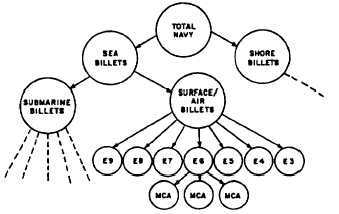| |
prisoners, or holdees, and who are counted using the
assigned rate fields or distribution NEC fields as shown
on the Enlisted Distribution Verification Report
(EDVR). Normally, personnel assets and billets are
managed by ratings. However, because of highly
specialized training, certain individuals and billets are
managed by the NEC independent of rating. When
BUPERS determines that an NEC will be managed as a
distributable community, independent of rating, the
NEC is designated either Closed Loop or Transitory.
The Closed Loop NEC distributable community
consists of personnel who are projected and assigned to
consecutive tours within that NEC skill area.
A Closed Loop NEC distributable community is
normally associated with one rating or group of ratings
sharing a common occupational skill, and where the
member has earned a highly specialized talent within his
or her general rating experience. The person is managed
based solely on this NEC skill.
A Transitory NEC distributable community consists
of a combination of ratings sharing a common
supplemental skill that may not be generically
associated with the individual’s actual rating. This
individual is managed by the NEC only during
completion of a Transitory NEC tour; the member is
reassigned to a requirement within his or her primary
rating.
. Detailing composites. Having determined the
individuals and billets that will be managed by rating or
NEC, the total Navy billet structure is subdivided into
detailing composites. The first division designates
billets as either sea or shore. This sea/shore division
indicates whether a billet is counted as sea duty or shore
duty for personnel rotation. The sea and shore
composites are further subdivided into submarine billets
and nonsubmarine billets. The nonsubmarine composite
is termed the sea-surface/air composite. The shore,
sea-surface/air, and sea-submarine composites are again
subdivided into seven paygrades. (Paygrades E-1
through E-3 are considered one paygrade in this
division.) Finally, each paygrade is subdivided into four
MCAs representing the billets for which each of the
MCAs has responsibility. Figure 3-1 shows these
detailing subdivisions. The end result is to project future
personnel strength and allocate personnel assets to each
MCA by paygrade within the rating or NEC.
Considering each rating and NEC distributable
community and the subdivisions, the system is capable
of projecting and allocating these assets to some 3,300
distinct detailing communities.
Figure 3-1.-Breakdown of detailing communities.
Navy Manning Plan
Since personnel assets rarely equal manpower
requirements, distribution managers are faced with the
problem of how best to use assets that are short or those
in excess of personnel requirements. To solve this
problem requires a manning plan that will determine
how shortages and excesses will be distributed. This
plan is called the Navy Manning Plan (NMP). Using the
projected level of assets and the billets authorized to
activities, the NMP determines the most equitable level
of manning an activity can expect. Additional
information concerning the NMP can be obtained from
the Enlisted Transfer Manual (ENLTRANSMAN),
NAVPERS 15909D, chapter 1.
Personnel Requisition
The projection system predicts the level of
manpower assets and provides a base upon which the
MCA can build a manning plan that will provide an
equitable distribution of the assets to each activity. Each
MCA must communicate its activity’s qualitative and
quantitative personnel needs to the ACA. This
communication is provided by the personnel requisition
system. The personnel requisition’s function is to
measure activity personnel needs to bring the activity
first to its manning plan, and second, if assets are
available, from manning plan to full allowance. A
second function is to communicate to the ACA in what
sequence personnel are to be assigned to activities in
order to fill their requisitions.
Requisition Priorities
The Chief of Naval Operations (CNO) and the
MCAs have directed that certain activities be given
priority in the assignment of personnel assets. These
3-2
|

